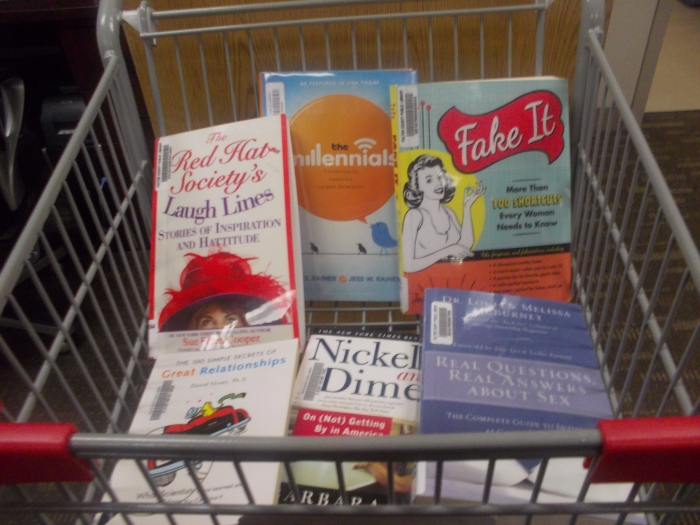
The next category of the Dewey Decimal System explores a very wide array of social categories and systems. This section is so broad that I will need to split it up for comment. Today I’ve chosen to comment on the first two Dewey subcategories of Sociology & Anthropology and Statistics.
In the beginning of the 300 section, there are many books about specific groups of people. I read about what it takes to have great relationships, a whole generation of Millennials, the Red Hat Society, women in general, the poor, and people trapped in dead end jobs (aka the working poor). Books with numbers from 300-309 make up the Sociology and Anthropology books. I’ve chosen to mention just a small representative cartload of books in this category .

Brief comments in Dewey Order follow:
The 100 Simple Secrets of Great Relationships by David Niven, Ph.D: Sharing simple secrets of great relationships, this book claims to share what scientists have discovered and tell you how to use those discoveries in your own relationships. A quick read, the book has some interesting secrets.
The Millennials Connecting to America’s Largest Generation by Thom S. Rainer and Jess W. Rainer : This was a very positive and informative book about the millennial generation. I was born pretty much on the dividing line of the Baby Boomer/Millennial generation. In some ways I’ve always felt I have a foot in both generations and it was interesting to me to see how much of the overlap is significant to my life. Additionally I have a tadpole who is a Millennial and it is interesting to see how her world differed from mine growing up. I have read other things about Millennials which basically forecast the gloom and doom of our changing world, but I found this particular book to be a refreshing, hopeful, and positive statement of the people who are taking over the next generation.
The Red Hat Society’s Laugh Lines Stories of Inspiration and Hattitude by Sue Ellen Cooper: This book pokes fun at women over 50 who do not want to grow up and still want to have some play time. It is a good illustration of life to be lived after 50.
Fake It More than 100 Shortcuts Every Woman Needs to Know by Jennifer Byrne :This is a quick read and somewhat humorous book about women finding time to accomplish everything they need to accomplish. While many of the shortcuts are helpful, some are more tongue-in-cheek.
Nickel and Dimed On (Not) Getting By in America by Barbara Ehrenreich: This book explores the fact that millions of Americans work full time for poverty level wages and can’t make ends meet for even the most basic of necessities. The author took the unique approach of going undercover and living among the working poor in order to research this topic. It is interesting to note that she herself would not have been able to make it without the safety net she kept in place for herself; a net not available to the working poor. In my opinion, everyone needs to read this book.
Real Questions, Real Answers About Sex The Complete Guide to Intimacy As God Intended by Dr. Louis & Melissa McBurney: The authors have divided this book into six sections and leave no stone unturned. This book is appropriate to engaged as well as married couples and is filled with good advice. In my read through of the library, I have come across many books on this topic and this is by far the best book of them all. I highly recommend it.
Even though I am reading through the library, there are certain categories of books that I dread reaching. When I saw that statistics was one of the Dewey categories, I was rather dreading it. I did not enjoy statistics in college! As it turns out, the statistics category has been shrinking in most libraries and I found only 3 (!) books numbered from 310-319.

These books have been moved to the Reference Section of the library. As these actually are used as reference books, there isn’t much “review” to be done. Instead I will just comment that the probable shrinkage of this category of books is due to the Internet and information being readily available. This type of information could change by the time statistical books are published. You can probably surmise by these surviving books that Fulton County Public Library is located in a rural area of Indiana.
